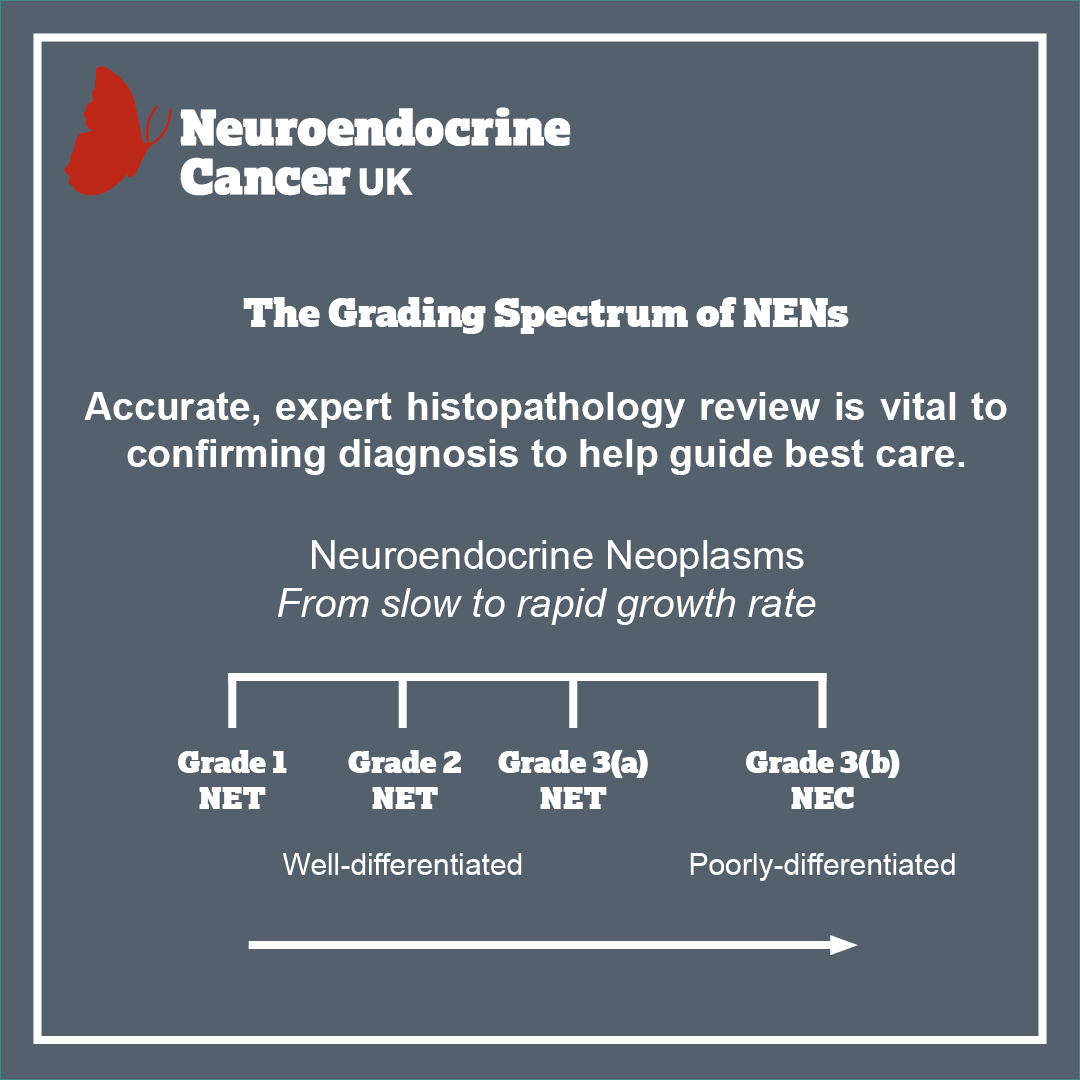NEUROENDOCRINE CANCER OF THE
SMALL BOWEL
The Facts
Neuroendocrine Neoplasm (NENs) is an umbrella term used to cover a group of cancers that start in neuroendocrine cells. These cancers may also be referred to as NETs, NECs, or even Carcinoids. NENs occur when neuroendocrine cells stop working normally and start to grow or behave abnormally.
There are 2 key types of NEN:
- NETs (neuroendocrine tumours) are called ‘well-differentiated’ and tend to have a slow to moderate growth pattern.
- NECs (neuroendocrine carcinomas) – are called ‘poorly differentiated’ and tend to grow rapidly.
To simplify, we use the term NENs throughout this page.
Select play to watch Dr Raj Srirajaskanthan discuss small and large bowel Neuroendocrine Cancers. This video was recorded as part of the Neuroendocrine Cancer UK Virtual Summit 2020.
Small Bowel NEN
The small bowel (or small intestine) is the longest part of the digestive system. It is only about as wide around as a middle finger (approximately 1 inch or 2.5 centimetres) and is, on average, 600 centimetres in length in an adult (we need at least 200 centimetres to maintain normal function).
The small bowel is anchored within the abdomen by a double fold of peritoneum (lining of the abdomen) called the mesentery. Lymph nodes and the blood supply to the intestines run through it.
It is not uncommon for NENs of the small bowel to be diagnosed because of acute symptoms, such as; bowel obstruction, ischaemia, or chronic symptoms such as Irritable Bowel Syndrome (IBS). You may also experience symptoms of Carcinoid Syndrome (dry flushing, diarrhoea / change in bowel habit). See our Secondary Site Factsheet for more details.
It is also possible that you may be diagnosed through a scan showing an enlarged lump of lymph nodes or ‘mass’ within the mesentery, especially if the primary NEN itself may be too small to be immediately visible.
Symptoms
Symptoms that may or may not include Neuroendocrine Cancer associated syndromes. (A syndrome is 2 or more associated symptoms)
Small Bowel Neuroendocrine Cancer, in early stage disease, can be a very silent disease – in that symptoms may not be present, however, if symptoms do occur, they may be due to size and position of the cancer – and how it is growing:
They may be acute (sudden and severe) – for example; signs of bowel obstruction – increasingly severe abdominal pain/cramping associated with vomiting.
Or chronic (occur over time and change in severity and frequency) – for example may be similar to symptoms of Irritable Bowel Disease – abdominal discomfort/cramping, diarrhoea, bloating, altered bowel habit.
Although Carcinoid Syndrome may also occur at this point, it is more commonly associated with disease that has spread (metastasised) to the liver – symptoms include:
- ‘Dry’ flushing : a red ‘blush’ of the face, neck and chest (which can extend over the whole body), and may be associated with pins & needles in hands and feet, headache and / or palpitations (fast-beating, fluttering or pounding heart)
- Diarrhoea : watery, loose stools multiple times a day—sometimes associated with considerable urgency – that may be more urgent/frequent in early hours to mid morning
- Carcinoid / valvular heart disease
- Wheezing (bronchospasm) and / or shortness of breath
- And/or skin changes
The syndrome is caused by the Neuroendocrine Cancer: the abnormal neuroendocrine cells within it, can release higher than normal levels of the peptides and hormones they would normally produce – causing altered function, leading to the symptoms described above.
Later symptoms may include scaly, irritated skin (caused by a lack of the vitamin B3 – niacin), arthritis, muscular weakness (myopathy), and symptoms related to secondaries in the liver and / or Carcinoid Heart Disease.
Further information on Carcinoid Heart Disease and Neuroendocrine Cancer Associated Syndromes is available here.
Tests
Tests that may be used for the diagnosis and / or monitoring of Neuroendocrine Cancer of the Small Bowel.
Bloods and / or urine:
Full blood count
B12 + serum Iron
Liver and kidney function
Chromogranin A (and B)
Urinary 5-HIAA
Full Gut Hormone Profile
NT-Pro-BNP – to check for evidence of Carcinoid Heart Disease
Calcium
Glucose
(Thyroid function)
Vitamin and trace element/mineral check alongside formal dietetic assessment is advised at baseline and as clinically indicated in follow up : Vitamin D, B3 & B12 deficiency and evidence of early malnutrition in symptomatic patients is not uncommon.
Scans and other tests:
Echocardiogram : as a baseline in the presence of carcinoid syndrome / raised U5HiAA and / or elevated NT-Pro-BNP +/- clinical signs of heart valve impairment/R sided heart failure
Colonoscopy : may be useful in detecting distal ileal disease and for excluding other colorectal abnormalities
VCE – video capsule endoscopy –
CT thorax/abdo/pelvis or MRI abdo/pelvis + CT chest
CT enterolysis (a CT examination of the small bowel)
Gallium-Dotatate PET/CT (SRS SPECT/CT if Dotatate PET n/a)
FDG-PET – if High Grade / rapidly progressing disease
Pathology (what can be seen through special tests under a microscope):
Differentiation and cellular morphology
Synaptophysin
Chromogranin
Ki67
cdx-2, p53 and / or SSTR 2a (optional)
Select play to watch this short video where Professor Martyn Caplin discusses Small Bowel Neuroendocrine Neoplasms.
Grading
Not all cancers are the same or behave in the same way. Some may grow very slowly, may not have invaded nearby structures, or spread to other parts of the body at the time of diagnosis – but they have the potential to. However some may have already spread at the time of diagnosis.
The grade is the rate at which the NEN grows. You might see this referred to as ‘Ki67’ or ‘Mitotic Index’ mentioned in your clinic letters or medical reports. Grade 1 is slow-growing through to Grade 3, a more aggressive, rapidly growing disease.

Select play to watch this more in depth video where Dr Raj Srirajaskanthan, Consultant Gastroenterologist, discusses Large & Small Bowel Neuroendocrine Cancers. Site specific tumours, incidence and prevalence, syndromes linked to the tumours and an overview of treatment.
Causes and / or risk factors
We do not know exactly what causes NENs, however research is ongoing, to truly understand both the pathology and the biology with the hope that this will lead to a much better understanding of the causes.
Most NENs do not run in families; however, there are a number of rare conditions that may increase your risk. Therefore, if other members of the family have been diagnosed with a particular cancer (especially aged 50 years or less) or cancer-associated genetic condition, it is important that you tell your specialist team about not only your medical history, but also any family medical illnesses or conditions.

So how is it treated?
For all patients, there are many things to consider in planning treatments. Your treatment will be personalised to you and the type of NEN you have. Even if you have a diagnosis that sounds the same as another patient, your treatment and follow up plan may be different.
Your care team will discuss your treatment options with you – giving you both written and verbal information – to help you make an informed choice. Together you can agree on the most appropriate treatment for you. There is consensus agreement that all NEN patients should be reviewed by a specialist MDT.
Treatment options will depend on the type, position and size of your NEN, and whether (or to where) it has spread. It will also depend on whether you have any other health concerns and / or illnesses and your general health and fitness. A big part of meeting with your doctors or specialist nurse/ team, is to make sure you get the information you need to understand.
Select play to watch this short video by Consultant HPB Surgeon, Zahir Soonawalla, about surgery for Small Intestinal Neuroendocrine Tumours.
The key aim of treatment, should be to help you have the best possible care and quality of life – by ensuring access to appropriate treatment, management of symptoms and addressing what’s most important to you
Treatment options will depend on the type, position and size of your cancer – and whether (and to where) it has spread.
It will also depend on whether you have any other health concerns and / or illnesses and your general health and fitness.
One or more of the approaches below may be suggested:
- Surgery
- Control of your disease, by slowing or stopping further growth and / or spread
- Palliation, or easing, of any symptoms you may be experiencing.
Surveillance:
Monitoring through clinic review, bloods and scans, can be used to assess how well treatment is working or in periods between treatments (which may be months/years).
As not everyone will need to be on treatment – surveillance can be used to check your cancer and general health for any signs of change that may mean that a treatment might need to be considered. All treatments have possible side-effects, therefore, it is important to know when treatment may be helpful for you or not.
Surgery:
To remove, partially remove or bypass neuroendocrine cancer and / or secondary sites of disease (metastases). Careful clinical and radiological (review of scans) assessment is required in planning surgery of the small bowel due to the complexity of the mesentery –
- Blood supply to remaining bowel needs to be maintained
- Assessment of how much small bowel will need to be resected to remove cancer but maintain function.
Small bowel segmental resection:
Removal a specific segment of the small bowel
Ileo-caecal valve resection:
Terminal ileum, ileo-caecal valve and part of the right colon is removed.
Ileocaecal valve resection plus right hemicolectomy:
Terminal ileum, ileo-caecal valve and all of the right colon is removed.
+/- Mesenteric mass / lymph node resection : removal of mesenteric mass and / or lymph nodes associated with mesenteric mass and / or primary tumour.
Non-surgical treatments:
- Somatostatin analogues (SSAs)
- Chemotherapy
- Targeted Molecular Therapies
- Peptide receptor radionuclide therapy (PRRT)
- Endoscopic procedure
- Interventional radiology
- Clinical Trials
- Symptom Control.

Follow up
There are expert agreed guidelines regarding how and when follow up should occur, however, in practice this varies and often with good reason – follow up should be expert informed & evidence /research based but also tailored to you and what is appropriate for your best care.
Following surgery:
Grade 1 or 2:
- Surgery undertaken with curative intent: 6-12 monthly CT* + bloods and urine
- Non-curative surgery / residual disease: 3-6monthly CT* + bloods and urine.
Grade 3a and b:
- 3 monthly CT* + bloods and urine
CT*: Chest, abdomen and pelvis
If long term can replace CT abdomen/pelvis with MRI abdomen/pelvis but will need to continue CT chest.
Functional imaging:
If recurrence / progression suspected.
- Grade 1-3a : Gallium-Dotatate PET/CT (SRS SPECT/CT if Dotatate PET n/a)
- Grade 3a and b : FDG-PET – if High Grade / rapidly progressing disease
Inoperable disease: as per non-curative protocol. N.B. high lifelong risk of sub-acute/acute small bowel obstruction and / or ischaemia.
Consensus guidelines recommend lifelong surveillance.
Nutritional assessment and ongoing monitoring, as clinically indicated, is also advised.
Advanced disease:
Follow up as per guidelines – but should be guided by prognosis, expected treatment efficacy and treatment related toxicity.
Your health, well-being, physical activity, informed choice and preference for ongoing care as well as aim of treatment should be reviewed and discussed to best plan care.
